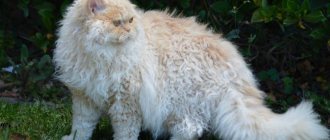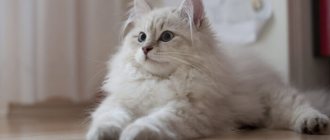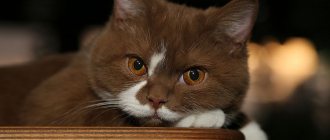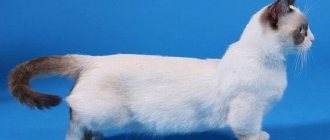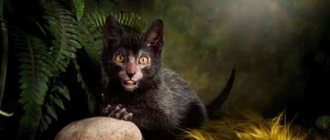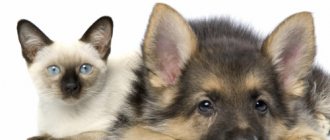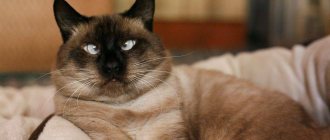Created: 08/09/2018
Updated: 02/26/2021 13:54:58Share:
Author of the article: Rudenko Irina Sergeevna
*Review of the best according to the editors of expertology.ru. About the selection criteria. This material is subjective in nature, does not constitute advertising and does not serve as a purchase guide. Before purchasing, consultation with a specialist is required.
The choice of a cat must be approached with all responsibility. After all, this is not just a pet. This is a friend for many long years - and it depends on the breed whether it will delight you or, on the contrary, bully and frighten you.
We have compiled a rating of the 18 best cat breeds that are suitable for both an experienced breeder and a novice fancier.
Pros of cats
Cat lovers, as lovers of these animals are sometimes called, find many benefits from living under the same roof with furry pets. They replace sleeping pills, helping to sleep soundly, bringing peace of mind, and reducing the likelihood of death from a heart attack. If there is no allergy, the risk of asthma is reduced.
Most cats are completely independent animals that can remain at home completely painlessly while their owners work for a long time. For a busy person, this is also convenient because you don’t need to find a “window” in your busy schedule for a walk twice a day. Many adults, and most children, simply adore cats.
Children love cats very much
The fluffiest cats for an apartment
The following furry pets are suitable for keeping in an apartment:
- Angora is a graceful cat with a peaceful disposition.
- Ragamuffin is the owner of a surprisingly luxurious fur coat that requires special care. The cat needs to be bathed and brushed.
- The Persian cat is fluffy and imposing. Requires care.
- The Siberian cat is beautiful and proud of its luxurious tail. The fur is moderately fluffy and does not tangle too much.
- The fur coat of a Kimra cat is comparable to that of a rabbit to the touch. The cat is not a timid cat and is capable of protecting its owner.
"Apartment" breeds
There are quite a few breeds that are ideal for apartment living.
For small spaces
Such cats should not be very large in size, with an average level of activity. The following breeds meet these requirements:
- Persian;
- sphinxes - Canadian, Donskoy, Peterbald;
- Russian blue;
- British Shorthair;
- Scottish fold and straight-eared.
Our portal contains an interesting article about cats of different breeds with a blue (smoky) color, read it - you won’t regret it.
Scottish Fold is great for small spaces
Attention! You should not take hyperactive Siamese, Abyssinians, Bengals and other similar breeds into a small apartment. Lack of exercise is harmful to their health.
Easy to care for
A common requirement when choosing a cat for an apartment is ease of care. The least problems are caused by sphinxes that lack hair. In addition, they are characterized by reduced sexual activity. This means that you don’t have to be afraid of the smell from the “marks”, as well as the inappropriate behavior of females during the period of “estrus”.
Hairless breeds are incredibly clean
The Scottish Fold breed has a short coat, so it rarely needs to be brushed. She is trainable and quickly gets used to the litter tray. These are pretty clean cats.
Character
Persians are the embodiment of calm. They idolize their owner and follow him everywhere. These cats rarely show aggression, even towards guests and children. Persians are silent and attract the owner's attention with their expressive gaze. Their disadvantage is their long coat, which requires grooming. And you will also have to put up with snoring. This is due to the structure of the nose. Their close relatives are the exotic shorthaired breed, which are somewhat easier to care for.
The Sacred Burma is intelligent, well trained, with “aristocratic manners.” She is affectionate and calm and does not get angry. Burmese get along well with other pets. But it has some disadvantages. For example, these cats are frightened by loud noises and do not tolerate heat well.
The Ragdoll needs the affection of its owner and cannot stand being alone. These are kind and patient cats. They rarely scratch, avoid conflicts, and are easy to train. Ragdolls cannot stand rudeness and are offended by such treatment. One of the disadvantages of the breed is that it must be protected from heights: the cat can be seriously injured if it falls, since it does not know how to group itself.
Ragdoll willingly accepts his owner's caresses
The following also have good character qualities for living in an apartment:
- British Shorthair;
- American Shorthair;
- Selkirk Rex;
- Manx;
- Neva Masquerade;
- European Shorthair;
- Russian blue;
- toyger;
- sokoke.
Sokoke - a gentle native of Africa
You can read more about the various breeds of modern cats, their maintenance and care in a special section on our portal.
Top 8 largest domestic cats
How to choose a cat breed
When choosing a kitten for your home, it is advisable to proceed from the characteristics and interests of the family, the presence of other pets, small children, and allergy sufferers. For a village or country house, ratcatcher cats are required. In an animal for an apartment, first of all, communication skills, the ability to get along with people, and a calm disposition are important.
Criterias of choice
Basic criteria for choosing a cat breed:
- owner's lifestyle;
- difficulty of care and maintenance;
- character;
- unusualness.
The owner's lifestyle. Busy working people, single pensioners, families with children should choose different purebred pets based on their usual lifestyle and time for a tailed pet.
- Independent cats that tolerate loneliness well in the absence of the owner - British Shorthair, Scottish Fold, Maine Coon. They do not require unnecessary attention, do not bother you if you are not in the mood, they will find something to do for themselves or will sleep peacefully on their favorite bed.
- If you want to buy a pet for a child, then it is appropriate to focus on kind, patient breeds that are able to leniently tolerate children's pranks and engage in joint games. Most often, playful lovers of pranks with an easy-going character are chosen for children: Norwegian Forest, Siamese, Bengal.
- A lonely person lacks communication; such people choose cats that are affectionate, loyal, affectionate and sociable. It will be nice to while away long evenings with them, talk about everything, sit in an embrace on a soft sofa. Affectionate, talkative breeds: Thai, Bengal, Cornish Rex.
- For a private home, it is better to choose a cat with a good hunting instinct to fight rodents. American Shorthair, Siberian, and Scottish Fold will be excellent at exterminating mice and rats.
- If the family already has pets, cats or dogs, then an American Bobtail, Thai, or Himalayan are ideal partners. They are friends with dogs, willingly play with other cats, sleep together, lick each other.
Difficulty in care and maintenance. Depending on its characteristics, each cat breed requires more or less attention and time for care, and is simple or difficult to maintain.
- The easiest to care for are unpretentious in food, without thinking through the daily menu, and short-haired pets that do not require combing or daily cleaning of the apartment when shedding.
- If you have the time and desire to carefully care for your tailed pet, then long-haired breeds, which often shed and require constant care for their fur, are ideal, as well as hairless breeds, whose representatives need to create a special temperature regime, constantly freeze or sweat, and therefore have to wash frequently.
- Difficult in keeping can also include the Persian with a specific flat muzzle, due to the structure of which diseases are often possible, the Scottish Fold with special care for unusually shaped ears, all varieties of Sphynx - hairless cats, which must be carefully warmed, without allowing thermal blows from overheating.
Character. Each breed of cat leaves its mark on the character of the animal, its temperament and disposition.
- There are talkative and sociable dogs that are suitable for those who are used to having philosophical conversations and cannot tolerate oppressive silence in the house: Canadian Sphynx, Siamese, Thai.
- The list of silent felines for which meowing is the exception rather than the rule includes the Cornish Rex, Siberian, and American Shorthair. They are turned on by people who value tranquility and who are irritated by unnecessary sounds.
- Active, active tailed cats, constantly in motion and exploring space, the owner will have to constantly come up with new activities, although they often find them themselves by examining the contents of cabinet drawers, shelves and racks. Prominent representatives of restless cats: Bengal, Abyssinian.
- The list of the laziest is headed by the British, Persian, and Siberian. It is important for them to eat heartily and sleep to their heart’s content. Sometimes owners may even forget about their presence in the house, the cats spend so much time in the kingdom of Morpheus.
- Loving people will be delighted with the most affectionate cats that constantly follow their owner in anticipation of hugs and other tenderness: Sphynx, Ragdoll, Burmese. You should only get them if you are ready to give your pet a lot of attention and affection.
- Intelligent breeds that are easy to train, understand human speech, and can learn simple commands. Smart cats - Siamese, Oriental, American Bobtail.
Unusuality. If the main thing for you in a cat is its unusual appearance, and you are willing to overpay for this, since the average price is quite high, then it is advisable to study the list of the most exotic breeds that are available in nurseries:
- American Curl - funny curled ears catch the eye;
- Devon Rex - has an alien appearance and huge ears;
- Cornish Rex - short curly fur, wedge-shaped head, thin limbs are touching;
- munchkin - characterized by a cute face of a plush toy, thick short legs;
- Laperm - unusually soft fur with large curls.
What should a breeder provide when selling a purebred kitten?
To avoid mistakes when choosing a purebred pet, be sure to require the seller to provide the following important points:
- Complete reliable information about the pet. If the seller hides information, refuses to answer, or does not know the answers to the questions asked, then this means that this is an incompetent breeder or reseller who may turn out to be a scammer.
- Full examination of the animal. You should pay attention to the condition of the kitten’s claws, teeth, ears, fur, eyes, degree of mobility and fatness. If the animal is too lethargic, timid, does not respond to external stimuli, or has problems with the above body parts, this may be a signal of a painful condition and the possible death of the animal subsequently. You should choose an inquisitive, confident, playful kitten with excellent physical characteristics.
- Documents - veterinary passport and birth certificate (pedigree). It is appropriate to contact the club with which the parents and litter are registered to ensure the authenticity of the documents. They should indicate the timing of vaccination, quarantine of the kitten, information about the animal’s mobility, temperament, exterior defects, maintenance rules, disease prevention, kitten skills, and features of preparation for exhibitions.
Some felinological clubs issue a certificate stating that the baby has no hereditary genetic diseases that may be characteristic of the breed.
Recommendations when choosing
If you want to buy a healthy purebred pet, it is advisable to follow a few tips from experienced cat lovers:
- When choosing a suitable breed, you need to study living stories and reviews on cat lovers forums, and not focus solely on breeders’ websites. The more information you collect about the breed, the more confident you will be in making the right choice.
- Carefully read the information provided by the seller and the kitten’s documents. Ask any questions you have, contact the club with a request about the parents and litter. If you have doubts about the purity of the breed, it is better to refuse the purchase.
- The metric should contain a description of important information: pedigree number, date of birth, parental information, breeder coordinates, breed, gender, nickname. The pet's veterinary passport must contain information about vaccinations against viral infectious diseases, rabies, dermatomycosis, preventive measures and examinations.
- When choosing a kitten, it is not enough to look only at a photo; it is appropriate to see it in person, and ideally, to also see the parents. The best option where to buy a purebred animal is at an exhibition where kittens are shown in detail.
- You should take into account the fact that purebred kittens cannot be cheap in price. How much an animal costs depends on the class: pet (for home keeping), breed (for breeding), show (for exhibition activities). The most inexpensive pets for the home at a budget price are offered from a selection of higher classes, with minor defects in the exterior.
Breeds for children
The choice of cat is narrowed if there is a child in the apartment. The following requirements are put forward for a pet:
- absence of aggression;
- flexible character, strong nervous system;
- sociability almost like a dog;
- ease of care.
Attention! Not all representatives of the breed have the necessary qualities, since cats also have different personalities. Therefore, when buying an animal, it is better to ask the breeder to choose a kitten for the home in which the child is growing up.
The following cats are considered the best according to these criteria:
- The Maine Coon is a real giant that grows up to 1 meter in length and weighs up to 10 kg (females - up to 8 kg). His character resembles a dog, and one of his habits is to meet and see off his owners. Maine Coons are sociable, pick up on the slightest changes in a person’s mood, and love to participate in the most important events of their family.
Maine Coon - house lion
- Canadian Sphynx . The hypoallergenic breed is suitable for families in which children are growing up with hypersensitivity to fur. “Canadians” have a peaceful character and are not prone to aggression. If kids are not afraid of the unusual “naked” appearance, they enjoy petting and hugging the animal because of its warm body and velvety skin. This is one of the most affectionate representatives of the cat world.
The Canadian Sphynx is very affectionate and warm
Attention! Lack of fur does not guarantee protection against animal allergies. Contrary to popular belief, the body’s hyperreaction does not occur to the lint itself, but to proteins in the animal’s biological fluids.
- Exotics . Exotic cats have a playful nature, they are sociable and curious. Such qualities are necessary for a cat to live in a family with a child. Snub-nosed cats are gentle and non-conflicting. When a child behaves aggressively, they simply move away without offering resistance. Unlike the Persian breed, they do not need to be combed.
Exotics are cute and non-conflicting
Sociable breeds
Siamese cats are ready to carry on a conversation with their owner, only in their own language
Among the four-legged friends there are those who like to talk with their owner. If you are not one of those who like constant silence in the apartment, and prefer to constantly communicate with your pet, then take a closer look at these breeds:
- Burmese cat. These are muscular, stocky pets with thick fur. They have different colors: blue, sable, platinum. The tails are mobile. They are ready to learn commands and don’t mind walking on a leash. Burmese cats are not picky eaters, intelligent and sociable. It is difficult for them to remain alone for a long time. They are characterized by diseases such as gum disease and diabetes.
- Oriental cats. Animals of this breed come in long-haired and short-haired varieties. They are sophisticated and have a flexible body. In nature, Orientals have about 300 colors. They are talkative and love to attract attention. Pets are suitable for large families with children. Orientals are predisposed to cardiomyopathy and gingivitis. They freeze quickly due to lack of undercoat.
- Siamese breed. The cats are distinguished by almond-shaped eyes with a slanted look, short fur of cream or milky white color. In addition, they are characterized by colored spots on their muzzle, ears, paws, and tail. Representatives of this breed are very sociable. They prefer to be among people and feel sad when alone. They are inquisitive and jealous. Pets are prone to dental problems. The diet of these animals affects their color.
- Don Sphynx. Animals with a wedge-shaped head, pronounced cheekbones and curled whiskers (some representatives have no whiskers). Their body is elongated and has fewer folds than the Canadian Sphynx. They are completely bald and have fluff. These are peace-loving cats that get along with other animals. They are susceptible to skin diseases.
Is it worth adopting a purebred cat?
Some people prefer "mutts". These cats did not have noble ancestors in their family or they have mixed roots. And this has its advantages. For example, mestizos have better health than their “blue-blooded” counterparts. This is due to the wider gene pool. Therefore, the risk of genetic diseases is very low.
However, such cats often have an independent character, and their hunting instincts are more pronounced. Adults love to mark territory, and it is not very easy to wean them from this habit.
The “mongrel” has better health
At the same time, purebred cats have predictable habits. They value cleanliness more because breeders select for breeding those individuals that are less prone to marking territory.
Breeds of kind and affectionate cats
Cats are rather proud and solitary animals, less attached to humans than dogs. However, in general, by their nature they are rather kind and affectionate; there are only a few aggressive varieties among them. VyborExpert specialists studied descriptions of the kindest and most affectionate pets. As a result, 2 options with an easy-going character were included in the rating.
Russian blue
The Russian Blue received its name due to its breeding on the basis of ancestors from Russia and due to the bluish tint of its coat. Her fur is not thick and short, so it does not create any problems with care. It is enough to comb the animal 1-2 times a week. The pet is quite large - weighing up to 3-7 kg. Height at the withers reaches 25 cm. On average, she lives 14-16 years.
The Russian Blue has long, muscular legs and sharp fangs, with which it easily catches rodents. It has good endurance and high speed, running away from other animals without any problems. A thin but dense coat reliably protects it from frost and rain. Due to the short length of the coat, this is a good option for allergy sufferers.
Advantages:
- Laskova;
- Flexible;
- Has a sense of tact;
- Curious;
- Playful.
Flaws:
- Regular cleaning of the tray is required;
- You need to constantly monitor the cleanliness of the bowl.
Speaking about which cat breed is better, the Russian Blue cannot be ignored because of its disgust and cleanliness, so it is suitable for exactly the same owners.
Siberian
The breed is of Russian origin, developed around the 16th century. She is a semi-long-haired breed, so she is easy to care for. The cats are quite large, weighing 6-10 kg. Their height at the withers reaches 30 cm in girls and 40 cm in boys. The animal lives the longest of all varieties - 15-20 years. The pet acts as a territory guard and fiercely defends its territorial rights.
The Siberian cat is characterized by intelligence and special intelligence. The animal has a well-developed hunting instinct and happily catches rodents and birds. The pet gets along easily with household members, but has an independent and proud character. She doesn't like strangers and loud voices, she needs comfort and tranquility.
Advantages:
- Gets along well with children;
- Likes to play;
- Sheds heavily;
- It is enough to bathe once every 3 months;
- You can feed it natural food.
Flaws:
- Does not get along well with other animals;
- Requires frequent walks in the fresh air.
Siberian representatives, due to their developed intelligence, are easy to learn and train. They get accustomed to the tray and scratching post without any problems.
At what age is it better to adopt a cat?
An adult cat or a cute baby? This seems like a minor issue, but age is an important factor.
Kitty
As a rule, kittens are taken into the house. It is believed that in childhood the animal gets used to the new environment better.
Attention! The kitten must be at least three months old.
A cat feeds its cubs with milk until they are three months old. This is important because the baby acquires primary immunity. It is the mother who takes best care of health and knows what her “child” needs. Communication with the parent is also responsible for socialization. An early break with a nursing female is fraught with the following problems for the offspring:
- mental disorders;
- behavioral disorders;
- weak immunity.
The mother accustoms the cubs to unfamiliar food, instills hygiene skills, shows how to use a tray and sharpen their claws.
Temporary immunity is transmitted to the kitten with milk.
Cats are vaccinated at 8 and 12 weeks (booster vaccination). Therefore, after 3 months the body is maximally protected from infections.
Adult cat
Animals older than a year are reluctant to be taken into an apartment due to prejudice. But veterinarians assure: often these are just myths that have no basis in reality.
Table 1. The most common misconceptions of future cat owners.
| Myth | Reality |
| It is easier to train a kitten to the litter box | Adults quickly understand what is wanted from them. And if they are already toilet trained, they will not shit anywhere, with rare exceptions and for “good reasons” (stress, illness, etc.) |
| An adult cat will not accept a new owner | Animals that have experienced cold and hunger appreciate taking care of themselves. Kittens take everything for granted and are spoiled |
| The child needs a kitten | Adult cats are more tolerant of children. Many of them have the talent of a nanny and stoically endure the importunity of children. |
| The owners abandoned the cat because he behaved badly | An animal may be left without owners due to their death, relocation, birth of a child, or other “harmless” reasons. |
| If you take a kitten, it will grow up healthy | This is not a fact due to unformed immunity. Kittens are more prone to serious illnesses and suffer more severely from infections. |
Adult cats are often more comfortable than kittens
The cleanest cats for indoors
For home keeping, not only the agreeableness of character is important, but also the cleanliness of the pet:
- The Russian Blue cat is carefully groomed, its fur is smooth and clean. A pet accustomed to water will not refuse to bathe.
- The Cornish Rex is a very low shedding breed. The pet's fur feels like velor to the touch.
- Rarely shedding options include the Oriental breed. In addition, the cat does not rush around the apartment.
- The Scottish Fold cat has short and very soft fur. Smart, clean and affectionate.
- The Scottish Fold looks like a Scot. The coat is short and licks well. You can get used to water procedures.
Is it possible to adopt a cat from a shelter?
People who decided to take such a step believe that it was done correctly. They argue that there are many reasons why a shelter cat will do well in an apartment.
Table 2. Pros and cons of a shelter cat.
| Advantages | Flaws |
|
|
As for communication with curators, this is a temporary phenomenon. As soon as volunteers or shelter workers understand that their pupil is in good hands, they stop disturbing the new owner.
Don't be afraid to adopt a cat from a shelter - this has its advantages
Shelters are also found through social networks - usually such organizations have pages. If you couldn’t find an adoption center in your city, you will definitely find one in a neighboring town.
For reference. ADOPTION
(from Latin
adoptio
- adoption), a form of establishing artificial kinship - the inclusion of an individual or several individuals in any related group or family. The motives for adoption could be different: providing a lonely person with a certain status in the system of social connections...Lifehack. From several institutions, the smallest ones are chosen, with the number of inhabitants up to 50 individuals. The cats there are more well-groomed and better cared for.
The most original cats for home
If you want to have a pet with an unusual appearance, check out these options:
- The Minskin cat looks like a hobbit. Thick and dense hair covers certain areas of the cat's naked body - the head, ears, paws and tail.
- Dwelf looks like an alien from another planet. A small head with large eyes and ears curved inward, a long, squat body, devoid of hair.
- Mei-kun is a giant among cat breeds. He is good-natured, endowed with soft fluffy hair and cute tassels on his ears.
- The Savannah cat has a leopard coloration. She is large in size, with a good-natured character. Willingly keeps the owner company on a walk.
- The Japanese Bobtail is a cat with an unusual, rabbit-like tail. He is active and intelligent, receptive to training.
Boy or girl?
When a family decides to adopt a kitten, among other things, the question arises: is a boy better or a girl?
Advantages of cats (females):
- they are cleaner because they take better care of themselves;
- do not seek to dominate;
- more flexible and affectionate.
But with the advent of puberty, the owner has a question: what to do with the offspring? There may be problems with this if the animal was not taken for breeding. Pregnancy is preceded by estrus. The cat leaves marks with a specific musky odor, and for a week or more makes loud noises, especially at night, calling for a male. This ends on its own or after mating with a cat.
Attention! Cats do not behave the same with men and women. Thus, they can “flirt” with representatives of the stronger sex - arching their backs, fluffing their tails. With women, females are softer and more affectionate.
Cats like to flirt with their owners
Cats are leaders by nature. They control every step of the inhabitants of the house. Most cats are not affectionate, although sometimes they allow themselves to be picked up and stroked. They become aggressive if a person does something they don't like.
One of the problems that cat owners face is marking their territory. Often, breeders manage to wean their pupils from such behavior. Males smell stronger. But the smell disappears if the animal is properly cared for.
Many problems can be solved by sterilization and castration. But even a castrated male can leave marks. This happens in the following cases:
- late castration;
- the presence of another cat;
- stress, anxiety;
- uneasy situation in the house;
- lack of attention from the owners;
- dirty tray;
- discontent;
- health problems, bladder infections.
Cats show aggression if they don't like something.
Potential difficulties of living with a cat
1. Cats go to the toilet . Yes, and “in a big way” too. Of course, cats are much more clean than dogs; they cannot go to the toilet due to carelessness or from excess emotions, but cats also happen to shit in the wrong place. There can be many reasons for this, but in this case the point is different - the area of the apartment is small, and the smell of cat excrement is quite pungent. This can cause problems with neighbors or homeowners. Therefore, it is preferable to choose animals that are already tray-trained.
Cat litter and kitten
If you think that cats are easy to train and their instincts themselves will push them in the right direction, you are mistaken. Our editor is the proud owner of two large mongrel cats, one of whom completely refuses to remember that a trash can is the wrong place for his litter box. And even if it is possible to convince him of this today, it is not a fact that tomorrow the situation with the surprise found in the trash bin will not repeat itself.
2. Cats shed . And this is also a problem. Are you ready for your entire apartment to be strewn with cat hair? It will get everywhere: on clothes, in food, on all surfaces. In a small space, especially during periods of seasonal molting, cat hair turns into a real punishment.
Grooming a long-haired white cat
Moreover, some cats periodically develop dandruff, to which you or your family members may be allergic. So, when choosing an animal, you need to remember about the upcoming “war” with its fur, and if this is a problem for you, it is better to choose smooth-haired breeds or sphinxes in general. On the other hand, with proper care, problems with the coat will practically not arise. In any case, it is worth paying attention to this issue.
3. Cat's temperament or character . In some cases, it can also present very unpleasant surprises. If you live in a relatively small apartment, you should choose a furry friend of a breed that has the following characteristics:
- lack of a pronounced instinct for one’s own territory;
- easy perception of loneliness;
- sociability;
- friendliness towards strangers;
- not too high activity.
Interesting: Portrait photos of cats
The last thing is worth explaining - cats with high activity require a lot of space for their games. They physically need to spend their energy somewhere, so they rush around the apartment like mad, turning over various objects, damaging furniture, knocking you off your feet. Such animals need to be in the fresh air, so keeping them in an apartment will be problematic for you.
Is it worth getting a cat?
Those who want to get a cat need to know what difficulties they will have to face, regardless of the breed and gender of the animal. A person who is used to traveling should realize that a cat is a homebody who does not like traveling. Rare pets agree to share the road with their owner and even go to the mountains with them.
You need to be patient in order to instill basic skills in your cat - teach him to go to the litter box and sharpen his claws not on furniture, but on a scratching post. Training requires perseverance from a person; training takes energy and time. If there is no desire to work with your pet in this direction, then soon the house will be a mess.
The cat needs to be taught basic skills - to learn to use the litter box.
Another difficulty awaits those who do not consider the possibility of spaying or neutering their pet. Several times a year you will have to go through the real hassle associated with sexual hunting.
Most cats sleep from morning to evening, especially if their owners spend all day at work and do not play with them during daylight hours. They are nocturnal. Therefore, you need to be prepared for the fact that your pet can disturb your sleep with its nightly activities. These are just some of the inconveniences that you will have to put up with.
Video - A cat travels with his “parents”
List of the best cat breeds with a calm character for an apartment
Friendly Siberian cat
Some owners prefer to have a balanced pet next to them. You can expect anything from non-pedigreed cats, because it is not always known who the pet’s parents were. If you need an animal with an easy-going character, we recommend paying attention to these cats:
- British shorthair cats quickly adapt to a new home. They are leisurely and non-aggressive. The British are quiet while their owner is at work. They have a dense and plush-to-the-touch coat that protects the animal well from the cold. These tailed animals are in good health, but they are also prone to food allergies and heart failure.
Short-haired British friend
- The Scottish Fold cat is an easygoing animal that easily gets used to people of any age. Because of their friendliness, they get along easily with other pets. Such cats are easy to train and unpretentious in food. They feel comfortable alone. One of their funny features is the ability to stand on their hind legs.
Scottish fold kitten
- Russian blue cats are distinguished by their intelligence. They are easy to train. Pets do not like to approach strangers, but are sociable with their owners and friendly towards children. These animals are not characterized by vindictiveness. They have problems with the respiratory tract and digestive tract disorders.
Elegant Russian Blue cat
- Persian cats have a flattened face. Animals of this breed have the longest hair among all cat breeds. They need attention and love to spend a lot of time with their owner. Quiet Persian cats rarely exhibit hunting instincts. Persians are not adapted to life outside the home. Difficulty in care - combing. Their fur quickly becomes matted.
Fluffy Persian cat
- The Siberian cat is calm and behaves unobtrusively. The pet loves to hide somewhere and watch the residents of the house. But sometimes he likes to play around, remembering his hunting instincts. Siberian cats have good health and no characteristic diseases.
Maine Coon
This is a calm, intelligent and independent cat. The breed comes from large cats living in the northern states of the USA. These wild animals were a natural population in those areas.
The most important distinguishing feature of the Maine Coon's character is its independence. The cat may not allow the inhabitants of the apartment to approach him, not allow him to be stroked, and even more so, to impose his will. At the same time, representatives of the breed are very gentle and kind towards children and play well with older children.
The Maine Coon is one of the largest cat breeds in the world and requires plenty of space to live at home.
Read more about the Maine Coon breed
Sphinxes
If you want a cat but don't want fur on your furniture, the Sphynx is your breed. Although at first glance shocking in its appearance, this cat actually adores its owner and is very extroverted and playful. Due to the lack of fur, the Sphynx loses more heat than others and must be kept warm.
Origin and popularity
The Sphynx is an artificial breed. European experts have been trying to create a cat without hair since 1960, and finally, in the mid-70s, they succeeded in creating the Sphynx. This breed is well known in North America and Europe, but is most preferred by owners in Russia and Canada.
Characteristic
Due to its specific appearance, the Sphinx requires careful care. Bathe him once a week, maximum once every two weeks. You can lubricate your skin with baby oil to avoid skin problems. Wear it when it's cold and be careful not to expose it to sunlight for long periods of time. Sphynx cats live on average about 20 years.
Abyssinian cat
One of the most characteristic features of the Abyssinian cat is the characteristic coloring of its short, fluffy coat. This is called "marking" and means that all hairs are a different color, no matter what hair is around them. Because most often these colors are in the brown-black range, and because of their characteristic ears, Abyssinian cats sometimes look like small lynxes.
Origin and popularity
The Abyssinian cat actually originates from Great Britain, although the name suggests an exotic origin. Abyssinian means Ethiopian, and the illusion that this breed originates from Ethiopia is the result of a legend that tells of English soldiers returning from North Africa with these little kittens in their arms.
After the middle of the last century, the Abyssinian cat became one of the most popular breeds, especially in the West.
Characteristic
These cats are suitable for owners who will really pay attention to them. They are smart and constantly play with them, and in their devotion to an attached person they resemble dogs. They received the nickname "Cat Clowns".
They often have dental problems that can lead to serious complications, so stay tuned.
Himalayan cat
Many people don't know that Himalayan cats are a mix of Persian and Siamese cats. Considering their appearance, it makes sense, doesn't it? These unusual cats have long fluffy fur in one and a specific decor in the other. What makes them completely different? Their bright blue eyes are something any cat lover will fall in love with.
Origin and popularity
Although the breed has gone by many names since then, the Himalayan cat first appeared in the United States in 1930 as the result of an intentional cross between a Persian and a Siamese. Its popularity began to rise in the 1950s, peaking in 1996 when it was the most common domestic cat in the Western world. And now he is in the top five.
Characteristic
Himalayas are kind, intelligent and sociable, making them excellent companions. They usually live more than 15 years unless their health is very poor. They most often have kidney problems.
